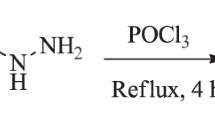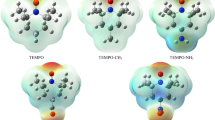Abstract
IN a number of publications1,2 it has been established that the reduction potential of aromatic compounds may be correlated with the π-electron energy change associated with the localization of electron or electrons at different positions of the molecule. Thus in the reduction of quinones the electron-localization took place at the two oxygen atoms, while in the case of aromatic hydrocarbons they were localized at the two p-carbon atoms. In the case of more complex compounds the localization may take place at certain groups of atoms undergoing reduction.
This is a preview of subscription content, access via your institution
Access options
Subscribe to this journal
Receive 51 print issues and online access
$199.00 per year
only $3.90 per issue
Buy this article
- Purchase on Springer Link
- Instant access to full article PDF
Prices may be subject to local taxes which are calculated during checkout
Similar content being viewed by others
References
Basu, Trans. Farad. Soc., 52, 6 (1956).
Basu and Bhattacharya, J. Chem. Phys., 25, 596 (1956).
Orgel, Cottrell, Dick and Sutton, Trans. Farad. Soc., 47, 113 (1951).
Kolthoff and Lingane, “Polarography”, 2 (Interscience, Inc., New York, 1952).
Maccoll Nature, 163, 178 (1949).
Author information
Authors and Affiliations
Rights and permissions
About this article
Cite this article
BASU, S., CHAUDHURI, J. Group Localization Energy and Polarographic Half-Wave Potentials of Aromatic Nitro Compounds. Nature 180, 1473–1474 (1957). https://doi.org/10.1038/1801473b0
Issue Date:
DOI: https://doi.org/10.1038/1801473b0
This article is cited by
-
Sadhan Basu ? a physical chemist extraordinaire
Resonance (2013)
-
Half-wave Potentials of Aromatic Ketones
Nature (1958)
-
Half-wave potentials of phenyl-substituted ethylenes
Die Naturwissenschaften (1958)
Comments
By submitting a comment you agree to abide by our Terms and Community Guidelines. If you find something abusive or that does not comply with our terms or guidelines please flag it as inappropriate.



